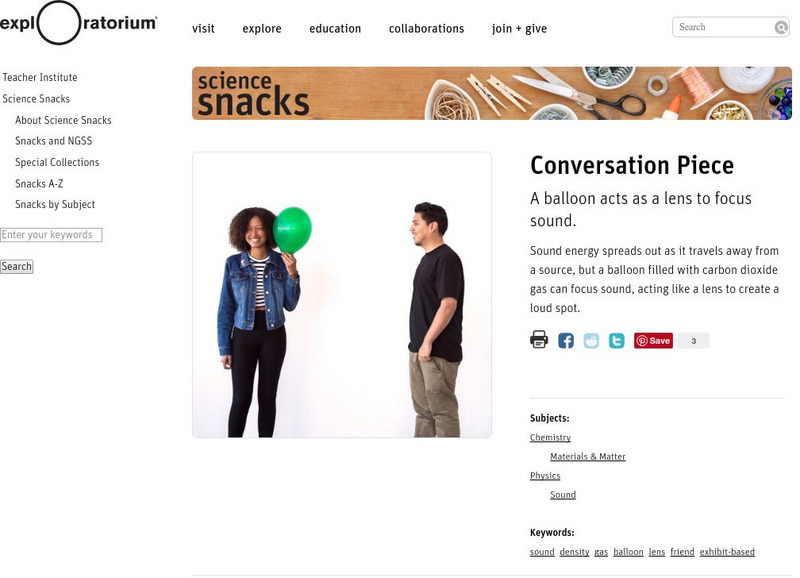Chiral Publishing
Chiral Publishing: An Introduction to Chemistry: Gay Lussac's Law
An interactive animation depicting the relationship between gas temperature and pressure. See what happens to the pressure of the gas molecules when the temperature is either increased or decreased.
Physics Aviary
Physics Aviary: Practice Problems: Temperature and Kinetic Energy Problem
This program asks students to determine the average KE of a gas molecule in a sample and then find the temperature of the particles that make up the sample based on the rms speed of the particles.
Physics Aviary
Physics Aviary: Practice Problems: Average Kinetic Energy and Rms Speed Problem
This program asks students to determine the average KE of a gas molecule in a sample and then find the rms speed of the particles that make up the sample.
Curated OER
Science Kids: Science Images: 3 D Carbon Monoxide Molecule
This is a computer generated 3D image of a carbon monoxide molecule. Carbon monoxide contains one carbon atom and one oxygen atom. It is an odorless gas that is highly toxic to humans.
The Wonder of Science
The Wonder of Science: Ms Ps1 1: Atomic Composition Model
A collection of lesson plans for helping students understand atomic composition. Site uses work samples, phenomena, assessment templates, and videos to plan lessons to describe the atomic composition of simple molecules.
Concord Consortium
Concord Consortium: Molecular Workbench Showcase: Chemistry, States of Matter
See how gas, liquid, and solid molecules react to external pressure in this simulation. Also see a model of intermolecular motion through elliptical particles.
Science Education Resource Center at Carleton College
Serc: Take a Deep Breath on the Appalachian Trail
A lesson plan that includes a PowerPoint learning module for students. They will examine spreadsheet data on air quality in Great Smoky National Parks, and solve problems using ratio and proportion. The exercises will help them to...
Purdue University
Purdue Univ: Gases, Liquids, and Solids
This site has a brief description of the differences in particles in a gas, liquid, and solid. Animated microscopic pictures demonstrate the molecular movement in each state. Information is then summarized in an easy-to-read chart.
Frostburg State University
Frostburg State Chemistry Online: Water Bond Angles & Phase Changes
Describes the bond angle of the water molecule during the transition from liquid to gas state. Also provides several examples and explanations for responses and answers given.
Science Education Resource Center at Carleton College
Serc: Exploring States of Matter Gases
In this series of chemistry labs, students learn about the three states of matter by observing how molecules contract or expand as they change state.
Sophia Learning
Sophia: Kinetic Energy and States of Matter: Lesson 1
This lesson will compare the relative kinetic energy possessed by molecules in different states. It is 1 of 2 in the series titled "Kinetic Energy and States of Matter."
Exploratorium
Exploratorium: Science Snacks: Conversation Piece
Did you know a balloon filled with carbon dioxide can act as an amplifier? In this activity test how sound travels through carbon dioxide molecules.
American Geosciences Institute
American Geosciences Institute: Earth Science Week: Chemistry of Burning
In this activity, students use pipe cleaners and foam balls to build a model of a hydrocarbon molecule. They then modify it to demonstrate the chemical reaction that happens when the hydrocarbon is burned.
CK-12 Foundation
Ck 12: Chemistry Simulation: Speedy Smells
[Free Registration/Login Required] Explore how the mass of a molecule affects how quickly a smell will reach our noses.
Bill Nye
Bill Nye: Sock It to Me
This tutorial by Bill Nye explains how evaporating water (or sweat!) can cool you down.
Simon Fraser University
Chem1 Virtual Textbook: Molecular Collision
The General Chemistry Virtual Textbook, or Chem 1, is broken into several sections covering various aspects of topics related to chemistry. This section seeks to answer the question, how far does a molecule travel between collisions?
American Chemical Society
Middle School Chemistry: Air, It's Really There
Explore the properties of air, and what happens to air when heated and cooled.
Museum of Science
The Atom's Family: Phases of Matter
Help the Phantom choose a material and observe the changes at different temperatures in the molecule chamber. What happens to the elements or molecules as the temperature changes?
New York University
New York University: States of Water
Use this resource to learn about the three different phases of water; solid, liquid, and gas. What happens to water as it changes into a solid or gas? Includes short and easy to do activity.
McREL International
Mc Rel: Whelmer #33 Learning Activity: Density Balloon
A simple activity that investigates the effect of heat on the volume of a gas. The activity is presented in lesson plan format that meets NSES standards.
PBS
Pbs Teachers: Bottle Fountain Experiment
Demonstrate how heating expands air molecules by constructing a bottle fountain powered by air pressure.
CK-12 Foundation
Ck 12: Plix: Structure of Water: Phases of Matter
[Free Registration/Login Required] Explore this interactive by dragging the red dots to match each physical state of water with the correct picture of its molecules.
Other
Atoms in Motion: Noble Gases
The ideal gas law is an empirical law; it's a relationship between the pressure in a system of gases to the volume, the temperature, and the number of gas atoms/molecules in the system. This "law" is valid if the gas atoms/molecules are...
Other
Atoms in Motion: All Matter Is Made of Atoms
Atoms are very, very small. Atoms are so small that it is often said that there are as many atoms in a single grain of sand as there are grains of sand on all of the world's beaches - certainly a difficult thing to prove, but you get the...














